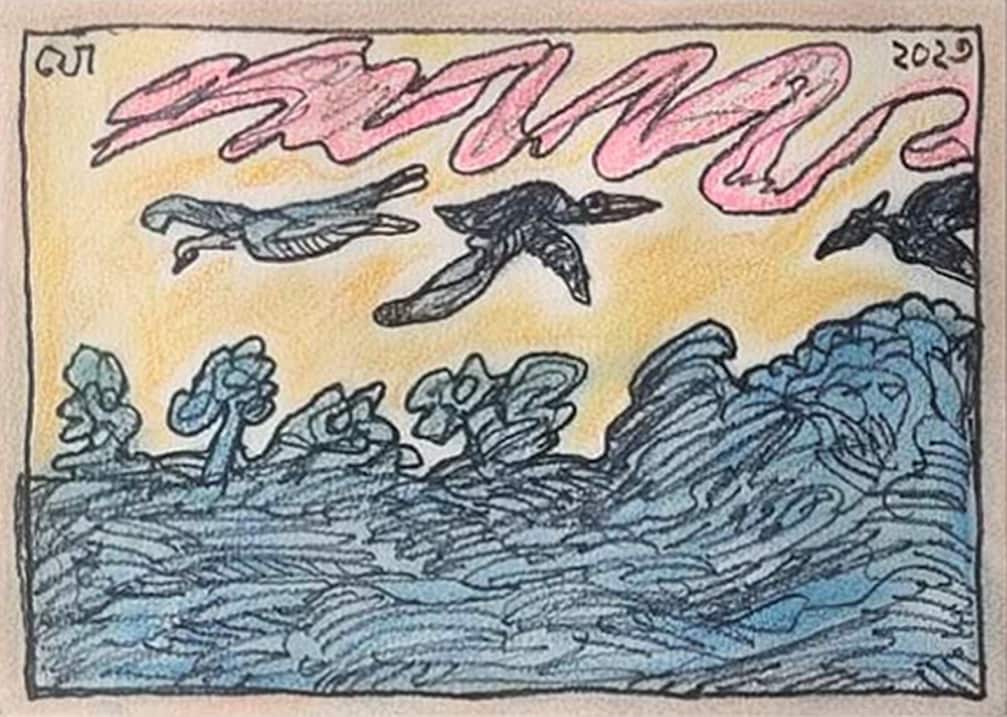Always a powerful artist, Chowdhury developed his individual style after his return from France in the late ’60s. Although Chowdhury has painted oils, his forte is painting in ink, water colour and pastel. The sinuous line contouring the flaccid figures, the crosshatching to achieve tonal variations distinguish C’howdhury’s paintings which show men and women enigmatic situations with provocative gestures placed in a dark dream-space.
Style : He has immense contribution in inspiring young artists of India. Jogen Chowdhury had developed his individual style after his return from Paris. His most famous paintings are in ink, water colour and pastel. He has painted in oil medium as well.
In Chowdhury’s more recent works the sensory experiences of cloth, bolsters, sofas and the human body are cross-projected to produce an uncanny world of tran-substantiated tumescence and flaccidness.
Jogen Chowdhury has been widely acknowledged to be, the master of the unbroken line. Like Léger, Chowdhury has been stirred by the linear Kalighat pat tradition, but his lines are emotive and used to express and suggest the character of a person. This is done by, distorting the form without breaking the line and in the world of young, contemporary art; distortion has been Jogen Chowdhury’s most significant impact. Perhaps, because of this, a common observation of his work is that his “people” are caricatures. The person feels familiar to the viewer but it is far more individualised – the face is imaginary but the psyche or characteristics are real. The power and beauty of his technique and line is this play between the known and unknown. In Jogen Chowdhury’s work, the figure is always in the foreground, it is primary, it conveys everything. He uses colour to give volume to his figures and the fluidity of his lines bring a sensual aspect to his forms.
About the Artist and his work :
Born : Born 1939 in Daharpara Village, Faridpur, Bangladesh. Jogen Chowdhury is an eminent Indian painter and considered an important painter of 21st century India.
Family Background :
His father Pramatnath Chowdhury was a Brahmin zamindar. Both his parents took interest in art, Jogen Chowdhury’s father Pramatnath Chowdhury painted several mythological scenes from the village theatres and also sculpted various Hindu icons. Whereas his mother was an expert in Alpana drawings.
1939-47 Jogen Chowdhury lived in a village atmosphere. And after partition in 1948, the whole family shifted. Till 1951 the whole family stayed at the police department quarter of his uncle, where on the walls Jogen Chowdhury painted his first painting, 1962 Jogen Chowdhury was employed as Designer in the Handloom Board.
Education :
1955-60: Studied at the Government College of Art and Crafts, Kolkata.
1965 : He went to paris to study in Ecole des Beaux Arts, in William Hayter’s Atelier 17.
Professional Experience :
1968-72 : He worked as an Art-Designer, Madras Handloom Board, Madras.
1970 : A collection of his poems were published, titled ‘Hridoy Train Beje Othey’.
1987 : Joined Kala Bhavan , Santiniketan as a professor of painting.
Selected Exhibitions :
1972, 1975 & 1978 respectively : I, III, IV Triennales at New Delhi .
1979: The Sao Paolo Biennale .
1980: The exhibitions at the Fukuoka Museum, Japan.
1982: The Royal Academy, London.
1982: The Hirschhorn Museum, Washington D.C.
1986: The II Havana Biennale
1989: ‘Festival of India’, in Geneva
2002: Saffron art & the Pundole art gallery, New York.
Honours and Awards :
2003 – Jury Member, Singapore Biennale Exhibition of Art, Singapore
2001 – Kalidas Sanman, Government of Madhya Pradesh
1986 – Received Award In the 2nd Biennale of Havana, Cuba
1966 – Awarded Prix le France de la Jeune Peinture, Paris
1965-67 – Awarded French Government Scholarship, Studied at L’Ecole Nationale Superiere des Beaux Arts and Atelier 17, Paris
1965 -67 – French Government Scholarship to Ecole Nationale, Superieure des Beaux -Arts, Paris.











